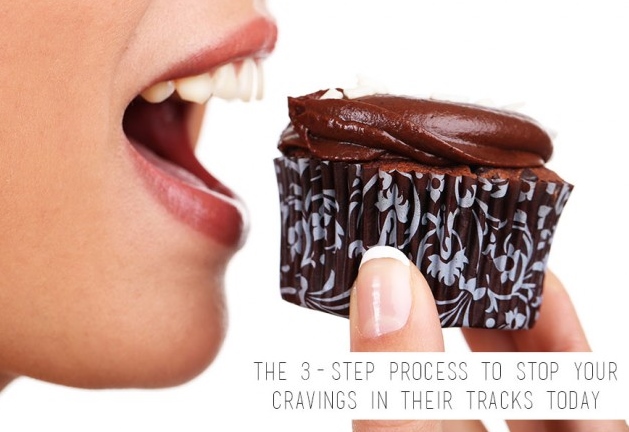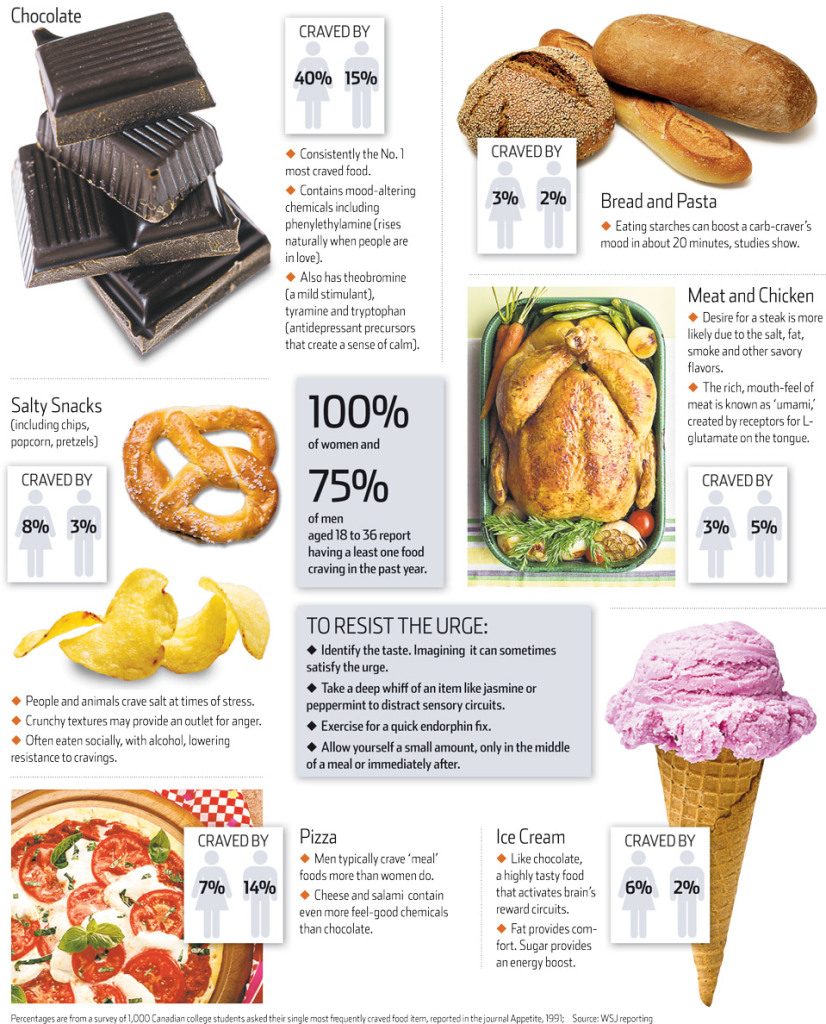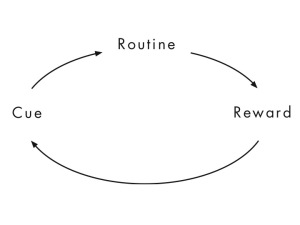 The Truth About Food Cravings
The Truth About Food Cravings
Craving a big, fluffy hunk of warm bread does not mean your body is deprived of grains. Food cravings have little to do with nutrients and plenty to do with the brain chemistry of pleasure and reward. Cravings may center on texture (creamy, crunchy) or taste (sweet, salty) but they all have something in common — overindulging can sabotage your diet.
We All Crave the Same Foods (More or Less)
When you get hungry, you crave food, but this is different from having a craving.
A craving is defined as a desire for a specific food or selection of foods, but not just food in general
When large groups of people are studied, their most common cravings are always the same.
People crave foods that taste good (are highly palatable). Chocolate, salty snacks, foods with additives like MSG, and pizza are all loved by a large majority of the population.
There’s a common myth that people crave foods with nutrients (vitamins and minerals) that they need. The human body is smart, but not that smart. Other than a rare condition called Pica, cravings have nothing to do with wanting specific nutrient. Otherwise, people would crave nutritious foods like spinach much more.
Here’s a great infographic that breaks down the common cravings:
The 3 True Underlying Causes of Most Cravings
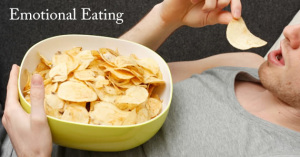 Cause #1: Emotion
Cause #1: Emotion
We try to make good decisions, and often succeed, but those emotional choices we make often lead to bad decisions. Many studies have revealed that emotions play a key part in when we start to crave for foods. Cravings have been linked to:
Boredom, Anxiety, Stress, Sadness, Guilt.
Why do Emotions Cause Cravings?
The most promising theory so far appears to be reward-based stress eating . The theory is based on the importance of cortisol and other appetite-regulating hormones.
When people get stressed, they release opioids, which are chemicals that relieve pain. It turns out that eating highly palatable foods can also release opioids, which is essentially a reward of eating certain foods. Studies have shown that many cravers feel better after eating what they craved.
It follows, then, that when we experience a negative emotional state, like stress or boredom, we might try to feel better by trying to produce more opioids through eating. It’s possible that the body initiates the craving on its own, or even that they are developed over time as a habit.
Cause #2: Restriction
Do you like being told what to do? The majority of people have an instinct to be free – to make their own choices.
Many studies have looked at the effects of dieting on cravings. Most dieters change what they eat by cutting out “bad foods” like chocolate and junk foods. This can lead to a “boring” and repetitive diet.
This restriction has been shown to increase craving frequency and intensity. One study found that under monotony (a very restrictive diet), cravings quadrupled
 The Pink Elephant Craving
The Pink Elephant Craving
When I tell you not to think about a pink elephant, do you think of a pink elephant? This classic example illustrates the second problem with cutting foods out of your diet. The less you can have something, the more you crave it
Cause #3: Habits (and Triggers)
Ever trained a pet to do a trick by offering a treat? Over time, your pet will automatically do the trick as the reward enforces the behavior. This is an example of classical conditioning.
Humans can also be conditioned:
- Did your homework? Have a cookie.
Ate your vegetables? Have dessert.
Want to watch T.V.? Eat your cereal first.
The specifics don’t matter, but just know that people tend to associate foods with events if they occur enough. Note that this can be related to emotions as well (e.g. going through a breakup? Drown your sorrows in ice cream).
All habits have 3 components: A cue (some call it a trigger), a routine, and a reward.
When we talk about food cravings, the routine is eating, and the reward is the pleasant taste and good feelings. So that leaves the trigger component.
There are a near-infinite amount of triggers in real life, but here are the most common that lead to cravings (and acting on them):
- Thinking about a certain food (the more vivid, the stronger the craving)
Smelling or seeing foods
Emotional states (as discussed earlier)
Events (e.g. dessert after dinner)
Habits can be unlearned, but it is tough.
How to Handle Your Cravings
 Option 1: Restricting Foods? Change Your Perspective
Option 1: Restricting Foods? Change Your Perspective
This is the most important thing that anyone trying to eat better can do.
Restricting foods is a good thing, as long as it doesn’t cause you to crave excessively and end up bingeing, which is bad for your mental and physical health.
But instead of thinking of it as: “I can’t eat bread anymore,” think of it as “I can eat bread, but I’m choosing not to in order to be healthier.”
And that’s a very simplistic example, but you can start with that and tailor it to your own personal situation.
To make it even more effective, instead of saying something general like “…to be healthier,” think of it in terms of the benefits you’ll receive. For example:
- …to have more energy
…to lose weight and feel more confident
…to be sick less often
etc.
Note: If you have extreme issues with negative thinking and cravings, you may want to seek professional help from a therapist. There have been great results shown from using cognitive behavioral modification techniques to reduce cravings
Option 2: Diet Change? Wait it Out
If you are coming from a drastically different diet, you are going to have more cravings than normal. It’s unavoidable, in many ways comparable to withdrawal that addicts face when trying to quit.
However, the bright side is that the cravings will subside in time. One particularly interesting study showed that cravings decrease over time as you adjust to a new diet, and low-carbohydrate diets are easier to get used to.
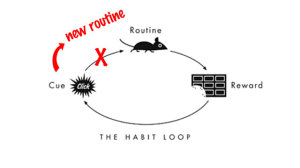 Option 3: Break or Hijack a Bad Habit
Option 3: Break or Hijack a Bad Habit
If you know that your cravings are a result of bad habits, you have no other choice but to try and break them, one at a time. You can either try to break them altogether, or try to replace the “routine” (food being eaten) with a different one, which is often easier.
Long story short, to hijack a habit when you crave a certain food, replace it with a healthy alternative. Each time you do this, a little bit of the craving will be transferred to that new food, until the habit is completely reformed.
Option 4: Compromise
Chocolate is the most common craving by far, but does it need to be eliminated from your diet? If you are craving chocolate, have a square or two of dark chocolate (the darker the better). This can eliminate the craving before it gets out of hand and causes you to eat too much.
 Option 5: Exercise or Distraction
Option 5: Exercise or Distraction
What do you do when you are exposed to a trigger and can’t stop thinking of a food?
One option is exercise. A fairly recent study showed that participants had a much lower craving response after exercising . Even a quick 5-minute workout can help keep those cravings at bay.
Another option is to distract your mind. While you can’t simply tell your brain to stop thinking about a food, you can get it to think about other things. One study showed that after doing an activity that engaged one of the senses (sight, smell, hearing), the intensity of a craving decreased.
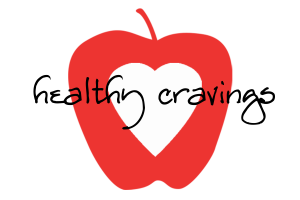 Summing It Up – Cravings in a Nutshell
Summing It Up – Cravings in a Nutshell
Experiencing some cravings is normal, as is giving in to them every once in awhile. Don’t feel bad or beat yourself up if you do give in, just keep trying.
If you think you have an issue with cravings, follow this 3-step procedure:
Write down any cravings you have, as well as when, where, and environmental factors when they occur.
After a few weeks, analyze your cravings and try to identify the causes of your cravings. See if they fall under one or more of the causes in this article.
Select appropriate solutions from above and implement them. Track your progress.
If you do those 3 things, you should see marked improvement in the frequency and intensity of your cravings. This will help you achieve the diet that you’ve been trying to eat.
There’s a common myth that people crave foods with nutrients (vitamins and minerals) that they need. The human body is smart, but not that smart. Other than a rare condition called Pica, cravings have nothing to do with wanting specific nutrient . Otherwise, people would crave nutritious foods like spinach much more.
The 3 True Underlying Causes of Most Cravings

